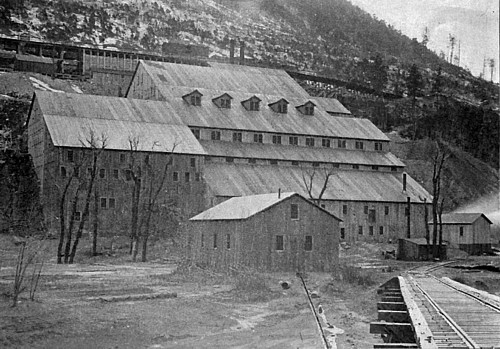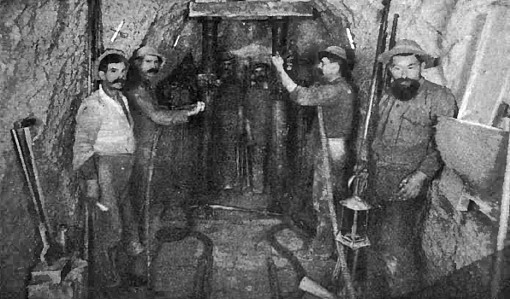CRIPPLE CREEK, like many another spot known to fame and history, received its name from an event of importance. Some years man attempted to cross the creek; his horse stumbled under him, he was thrown and had his leg broken, and from that time the before nameless stream has been known as "Cripple Creek." The name is neither euphoneous nor beautiful, but it is, at least, distinctive, and has at length secured prominent mention in the world's history, and a prominent place on the map of the United States. Whatever the name lacks in grace and beauty, the surroundings make ample compensation for. Beautiful, grand, and impressive, as many of the parks of the Rocky Mountains are, none excel that which holds in its wide embrace the marvelous gold mining district which has been opened to the world within the past few months. It is but a few short years that the fierce named the park at will and hunted the buffalo, deer, bear, and birds, then profuse in their abundance. Day after day these painted lured the half raw hides of the game they slaughtered, and stripped the pine trees for the primitive "hark soup," little dreaming that beneath their feet lay untold millions of native gold. The sun shone as brightly as it does to-day, and looked down with as kindly a glance upon the towering hills and undulating valleys of the beautiful park. The vast solitude was unbroken, save by the Indian and the native beasts and birds, until the more adventurous of the white men dip covered the rich and bountiful ranges, and began herding cattle in the sheltered valleys.
From the arrival of the first white man began the search for the hidden gold, but it is only within a year that the presence of the yellow metal, in large quantities, has been positively demonstrated. Repeated trials have been made, during the last twenty years, to find gold in this particular district, but so cunningly had the storehouse been concealed that even the most expert miners were deceived. There are thousands who remember the mad rush to Mount Pisgah, in April, 1885.
It is true, that the supposed rich deposit of gold was deposited there by human hands for speculative purposes; that the great mine in the new El Dorado was "salted," but there was gold within so short a distance of the place where this piece of knavery was practiced, that it seems almost miraculous the mining district was not located at the time. Many an old prospector has examined the outcroppings, and one was even confident enough to run a tunnel into the hill directly under the spot where one of the richest deposits has since been located, but none succeeded in finding the gold. This may seem strange; but if we take into consideration the fact that the most expert miners have since been " fooled" by the ore of this particular district, the wonder is accounted for. The gold ore was unlike any other, and was deposited in so unusual a manner that no one dreamed of looking at it for gold. In opening one of the mines, ore that ran thousands of dollars to the ton was thrown upon the dump as worthless. In order to explain how difficult it was to convince people that gold really existed in large quantities in the Cripple Creek district, and to give a brief history of its discovery, we append an article from the Rocky Mountain News, of February 28th: A way back in the sixties, when Hayden's party passed through this region, it came pretty close to discovering this camp. A man named Wood thought he saw promising indications on what is now Requa Creek, and in 1874, he, with Messrs. Requa, McGee, Brown, Coburn and Root, came over and dug a shaft fifteen feet deep, from which a tunnel was run. Wood was the man with the money, and conceived an idea that the others were not treating him fairly. The property was abandoned. Good mines are now opened on Squaw gulch and Wilson creek, which are on each side of Requa, and the men of 1874- might have done well had they continued operations. After that, prospectors poked around the hills from time to time, and it was a well known fact that colors of gold could be found in almost any stream, but the right man and the right place never came together.
"In 1879, one Calkins, working for W. W. Montelius, the Denver music man, went to work on Poverty gulch and ran a tunnel in for some distance. It is there, caved in and dilapidated, and forms an object lesson of fate, because it missed the mineral by about a hairs breadth. The real thing is so short a distance above it, and to the right, that a stone may be thrown down from one to the other. If Calkins had the favor of fortune, Cripple Creek would have been opened thirteen years ago, and he would have reaped great profit, because he had the place to himself. "The Pisgah gold rush excitement was another effort in the right direction, though it missed the mark. Cripple Creek lies east of Mount Pisgah, while the fields that came to nothing were west of it. Many of the disappointed men who went out of that country on foot, cursing their luck and the lack of Pullmans, would have done better had they turned to the east and investigated. "Robert Womack was the first man to find gold at Cripple Creek, and. unlike the discoverer of the rich mines at Creede, is said to be out of the good things that others found in his footsteps. Near the end of 1890, he found some good looking stuff which he carried to Colorado Springs to interest capital. The men with money had the Pisgah boom in mind, and took little stock in his assertions. He finally induced F. F. Friesbee, Dr. Grannis, and E. De La Vergne to have the ore assayed, and it ran over 200 ounces.
They came out to the camp January 24, 1891, and under the guidance of George W. Kerr, an old timer, who still resides at Cripple Creek, prosperous and happy, they took samples out of old prospect holes and from the hillsides, which assayed from $6 to $250 They returned and took up the El Dorado, after riding past the hill where the Blue Bell is located, refusing to touch it. The El Dorado is northeast of. the town, close to Cripple Creek and not very far from the Gold King. In partnership with De La Vergne and Frisbee, were J. F. Seldomridge and Judge E. A. Colburn. About the same time, Martin brothers took up claims on Globe Hill, which lies north of Gold Hill. "Just one year ago, yesterday, the Blue Bell was located by M. C. Lankford, W. L. Spell, J. E. Handbury, George W. Carr and J. S. Lentz. The first assay showed $43. Then the fact that there was something in the Cripple Creek district began to be told over the State and prospectors began to make their way in rapidly. Colorado Springs, being first on the ground, lost no time in getting on the inside, and the prominent men of that city have large holdings. The belief is abroad in the camp that they would have considerably more were it not for the reports made by Professor Lamb, who was not favorably impressed by the prospects.
"During the past summer and fall, ground was taken up rapidly, the value of the placer deposits attracted attention, and nothing but the absence of shipments prevented the great rush which commenced in the early part of December less than three months ago when it was learned that ore was coming out and that there was at least some solid backing for all the talk. " The real history of the camp is thus but a matter of days. The next six months will add volumes to it. "Cripple Creek has many odd features besides those under the ground. Snow doesn't lie deep. The last week past the gulches and hills around the town were practically bare. On the east side of the ridge, there was probably three times as much, though only a couple of miles away. Even there it was not deep. At night, fires may be seen flaring up in the distance. There is no occasion to become alarmed. They are merely the bonfires of industrious prospectors, who wish to keep the ground thawed out so they can work next day. "A couple of saloons boast of drawing cards in the form of pictures, which would cause Anthony Comstock to expire on the spot. Of another class, was the artist who constructed a water color effort which is much admired in the headquarters of one of the. assayers. It has the virtuous appearance of a study in whitewash, but it is labeled 'Michael Angels, price $8,000.' . At .the same place, is a queer gnarled roots mounted with ten-penny nails, which the tenderfoot is solemnly told is a petrified chicken."
Return
to The Colorado History Page:
Colorado Gold Rush History


